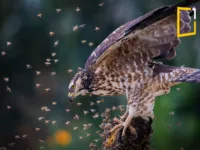The honey badger, also known as the ratel (Mellivora capensis), is one of the most fearless and fascinating creatures in the animal kingdom. Found across Africa, the Middle East, and parts of Asia, this small but mighty mammal has earned a legendary reputation for its resilience, tenacity, and audacious attitude. Despite its unassuming size, the honey badger is a force to be reckoned with, standing as a symbol of nature’s unyielding determination.
What Is a Honey Badger?
The honey badger is a medium-sized member of the mustelid family, which also includes otters, ferrets, and weasels. Adults typically weigh between 20 and 35 pounds (9–16 kg) and measure about 2.5 feet (75 cm) in length. Their distinctive black and white fur provides a striking contrast: the upper body is white or gray, while the lower half is jet black. This bold coloration is not just for show—it acts as a warning to predators and competitors alike.
Habitat and Range
Honey badgers are incredibly adaptable and can thrive in a variety of environments, including:
- Grasslands: Open savannahs with abundant prey and foraging opportunities.
- Deserts: Arid landscapes like the Kalahari Desert, where they use their digging skills to find food and water.
- Forests: Dense woodlands where they hunt smaller animals and scavenge for food.
Their range spans from southern Africa to the Arabian Peninsula and as far east as India, making them one of the most widespread carnivores in the world.

Show your fearless attitude!
Get the bold ‘Don’t Care‘ Honey Badger T-Shirt or phone case now – stand out in style!
👉 https://etsy.me/3AXkQM5
Unmatched Ferocity and Defense Mechanisms
What makes the honey badger truly remarkable is its fearless nature. Despite its size, it can take on much larger predators like lions, hyenas, and leopards. Here’s why the honey badger is considered nature’s ultimate warrior:
- Tough Skin: The honey badger’s skin is incredibly thick and loose, allowing it to withstand bites, stings, and even machete strikes. This loose skin also enables it to twist and bite back at attackers, even when pinned.
- Formidable Teeth and Claws: Equipped with sharp claws and powerful jaws, honey badgers can tear through bone and shell, giving them an advantage over prey and predators alike.
- Relentless Attitude: Known for their fearlessness, honey badgers will fight to the death if cornered. Their aggression often causes larger predators to think twice before engaging them.
- Resistance to Venom: Honey badgers are remarkably resistant to venom. They can survive the bites of deadly snakes like cobras, recovering quickly from what would otherwise be fatal.
Diet: More Than Just Honey
Contrary to their name, honey badgers don’t survive solely on honey. They are opportunistic omnivores with a diet that includes:
- Insects: Termites, beetles, and larvae are a staple of their diet.
- Small Mammals: Rodents, hares, and even young antelope are fair game.
- Reptiles: Snakes, including venomous species, make up a significant portion of their prey.
- Fruits and Roots: In times of scarcity, honey badgers will dig up roots and consume berries.
- Honey: Their love for honey is legendary. They raid beehives to feast on both honey and larvae, often in cooperation with the honeyguide bird.
Honey Badgers and the Honeyguide Bird
One of nature’s most fascinating partnerships is between the honey badger and the honeyguide bird. This bird leads honey badgers to beehives by calling and flying ahead of them. Once the badger breaks open the hive, both species share the spoils—an extraordinary example of mutualism in the wild.

Reproduction and Lifespan
Honey badgers are solitary animals, coming together only during the breeding season. Females give birth to one or two cubs after a gestation period of about six months. Cubs are born blind and hairless, relying entirely on their mothers for the first few months. The maternal bond is strong, with mothers fiercely protecting their young from predators.
In the wild, honey badgers typically live for 7–10 years, though they can survive longer in captivity.

Ready to Spread Your Wings?
Dive into the fascinating world of bird watching with “Bird Watching for Beginners”—your ultimate guide to becoming a birding expert! Whether you’re a nature lover or a curious beginner, this ebook has everything you need to start your journey. Click here to download your copy today and start exploring the beauty of birds!
Cultural Significance and Symbolism
The honey badger’s fearless demeanor has made it a cultural icon across the globe. It represents courage, resilience, and the willingness to stand up against overwhelming odds. In African folklore, the honey badger is often seen as a cunning and resourceful animal, embodying traits admired by many.
Threats and Conservation Status
Although honey badgers are not currently listed as endangered, they face several threats:
- Habitat Loss: Expanding human settlements and agriculture encroach on their natural habitats.
- Persecution: Farmers often kill honey badgers to protect their livestock and beehives.
- Poaching: In some regions, honey badgers are hunted for their pelts or body parts, which are used in traditional medicine.
Conservation efforts focus on educating communities about the ecological importance of honey badgers and implementing non-lethal methods to deter them from livestock and beehives.

Why the Honey Badger Matters
Honey badgers play a vital role in maintaining ecosystem balance. As opportunistic predators and scavengers, they help control populations of rodents, insects, and reptiles, preventing overpopulation. Their fearless pursuit of prey also contributes to the biodiversity of their habitats.
Fun Facts About the Honey Badger
- Honey badgers can dig burrows in under 10 minutes, thanks to their powerful claws.
- They’ve been known to raid campsites, opening cans and stealing food with surprising dexterity.
- Despite their small size, honey badgers are capable of scaring off lions with their sheer audacity.
- They are one of the few animals that have been observed using tools, such as rolling logs to climb fences.
Conclusion
The honey badger is a testament to nature’s ability to produce extraordinary creatures. Its fearless attitude, incredible resilience, and vital role in the ecosystem make it a true marvel of the animal kingdom. Whether admired for its toughness or its cunning, the honey badger is a reminder that strength isn’t always about size—it’s about spirit.
—————————————————————
Thanks for joining this wild ride. Stay curious, stay tuned, and let’s make our world brighter!
Subscribe to our channel and stay tuned for more intriguing mysteries and scientific wonders. Together, let’s uncover the secrets of the Earth and expand our understanding of this fascinating world.
Check out the latest blog and video on YouTube and learn something new today.
Attention, all readers! To deepen your understanding and stay informed on the latest news and trends, be sure to click on the link to access more informative articles.
Join the family by liking us on Facebook, or follow us on Twitter and Instagram.
If you liked this story, sign up for the weekly OneMinuteExplore features newsletter called “The Essential List”. A handpicked selection of stories from OneMinute Nature, Wildlife, Culture, Travel, Stories, and more… delivered to your inbox every Weekend.
👉 We may earn a commission from purchases made through links in this content, but it won’t affect your price. Rest assured, our recommendations are based on thorough research and genuine belief in the products. Your support through these links helps us continue providing valuable content. Thank you for your support!













